
A Mini-Guidebook to Cycle Touring Maui: A Figure Eight From Heaven
When we started planning our trip around Maui, we found it difficult to find information online. This mini-guidebook should hopefully answer most practical questions about cycling around Maui. For the story of our trip, see our other blog post. Basically, if you are already inspired to cycle around Maui, this is the place to get the nitty gritty details. If you are looking to get inspired, read the other post.
Weather: Expect Sun, Rain and Wind
On Maui the weather changes far more when you go from one end to the other, than it does when the seasons change – it rains about 20 times as much on the wet side (the Eastern side) than it does on the dry side (say around Kihei). Prepare for warm days and nights, with very sunny days and very rainy days. We brought rain jackets and a tarp, but skipped the rain pants, figuring (correctly) that it would be warm enough to forego them. We cycled with sandals rather than shoes, which work better on multiple counts – if it rains they don’t stay wet for long, they are more comfortable when it’s hot, and if you hang out at the beach they won’t fill up with sand.
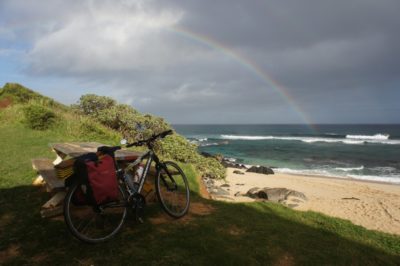
We had read that wind can be a serious hindrance when cycling around Maui, but at least when we were there, we didn’t find that to be the case. Probably we were lucky. If you are planning to cycle right around the island, looking at a wind chart doesn’t seem to do much good, since you are bound to spend about equal times in the theoretically tail-wind and head-wind areas.
Route: A Natural Figure Eight
Maui consists of two volcanoes stuck together, and hence the route around it is logically composed of two loops, or a figure-eight if you combine them. The “West Maui” (Lahaina) loop is shorter, easier and drier than the “East Maui” (Hana) loop. In order to keep the ocean on your right side, to have a clearer view of the ocean (and easier access for photo stops) which we’d recommend, it’s best to cycle both loops anti-clockwise. For the eastern loop, this also has the advantage of reaching Hana via the backdoor (the Piilani Highway) and leaving via the more usual route (the Hana Highway). This works well since the usual tourist thing to do is to head towards Hana in the morning and return in the afternoon, so you will spend most of your time against the traffic, which makes things easier on the narrow and windy Hana Highway.
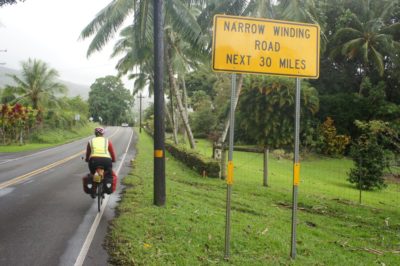
If you are planning to do both loops, it’s natural to ask which loop to do first. Our recommendation would be to cycle the western loop first, as we did, since it’s easier and shorter (a warmup) and in some ways less dramatic than the eastern loop. Note that to start the eastern loop, you have to head almost to the northern coast, since there is no direct road from Kihei, although it seems tantalizingly close. More accurately, you might notice on Google Earth that there is a direct and paved road, but it’s privately owned (apparently by Oprah) and gated. The longest continuous climb on the figure-eight loop is the climb up to Kula. We asked around and concluded that the best way up seems to be via Baldwin Ave., which starts in Paia. Since it’s a secondary road, it is relatively quiet, and has quite a bit of regular cyclist traffic. Another option is Pulehu Road, although the last mile or so is reportedly steep.
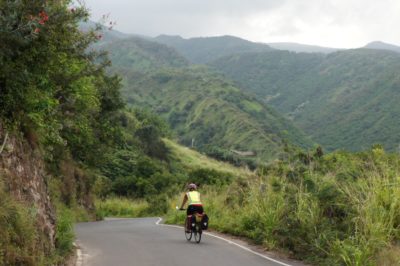
The backroad to Hana, called the Piilani Highway, was incredible and not to be missed – it was probably the highlight of our trip. The Piilani Highway has a few km’s of bad asphalt and a few km’s of gravel but it’s really not bad. Note that there is no (reliable) water between the Ulupalakua Ranch store and the Kaupo General Store, so fill up and if you plan to camp wild on the way (see below, there’s a great spot!), bring enough water with you. There are also no stores between Kula (we shopped at the Morihara Store, there is at least one more) and the Kaupo General Store, which is very basic (just snacks), the next good store is only in Hana (where they have everything), so plan accordingly.
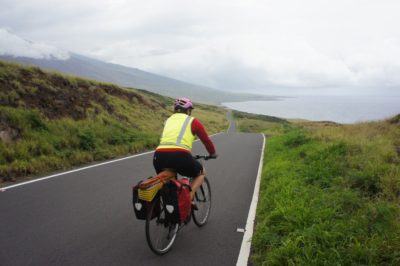
Roads: Some Narrow, Some Steep, but All Scenic
The roads we cycled were mostly of one of two varieties: type A were busy roads, with a smooth surface and a wide shoulder, type B were narrow and windy, full of blind corners and single lane bridges. The latter might sound scary, but we found that those sections tended to force cars to slow down to a crawl, so aside from a deviant driver or two, we found them reasonable to ride. We figure riding those sections is far safer than driving them, since as a cyclist you can always move to the side, and there will still be room for a car (even on the single lane sections) and as a cyclist you can hear cars coming, whereas motorized vehicle drivers cannot.
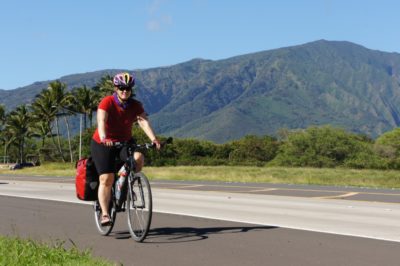
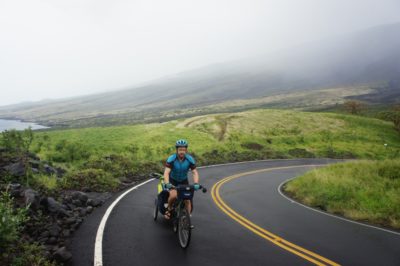
There are a few bicycle paths that are well worth using if you are on that route: there’s a separated cycling path alongside the Veteran’s Highway (Highway 311), all the way from Kahului to Kihei. There’s also a great separated bike path from Spreckelsville to Kanaha Beach Park, alongside the airport. Some sections that might look daunting on the map, such as Highway 380, from Māʻalaea to Kahului, were actually very enjoyable and scenic. In fact, almost all the roads we cycled were very scenic, and I often caught myself exclaiming “wow”, especially alongside the coastline (and most of our route follows the coast).

As for elevation gain, we found cycling around Maui to be quite strenuous. Certain sections keep going up and down, sometimes steeply, such as the Hana Highway, the Piilani Highway heading towards Kaupo, and the section from Kahului to Kipahulu, but none of those hills are very long. The only long hill that we cycled was the hill up to Kula, and it wasn’t steep, at least the way we chose (up Baldwin Ave. in Paia).
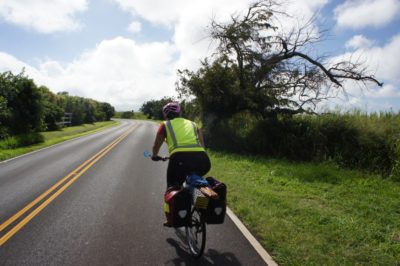
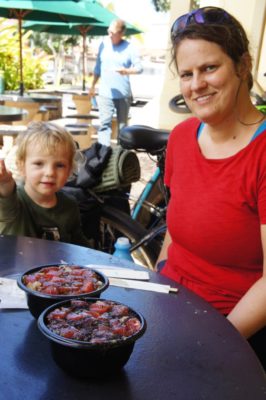
Food: Poke, Tacos, Coconuts, and Papayas
On our trip we camped almost every night, so we ended up cooking quite a bit. There are supermarkets and general stores in many locations, but due to our limited range we usually ended up carrying at least a few days of food. There are two relatively long sections without stores: from Kula to Hana (where there are two well stocked stores), and from Hana to Paia. As for eating out, a common recommendation from locals was to get Poke (a rice bowl with sashimi) for lunch at the Foodland Supermarkets, and once we tried it, we kept on coming back – it’s very tasty and cheap. Other than that, there are quite a few eateries on the route, many of which appear on Google Maps, and we enjoyed many excellent fish tacos (see our map for some recommendations of where to eat). Beware though – we did learn the perils of relying on Google Maps on the Hana Highway – the Nahiku Roadside and its food stalls was wrongly marked as being after Coconut Glen, and not before, so we totally missed it, and ended up eating our usual dry tortillas and cheese.
If you are like us and enjoy gleaning – collecting wild fruit along the way, you are in luck, since Hawaii is simply overflowing with fruit. Our trip was in February, not technically the “fruit season”, and yet we kept on picking loads of coconuts, papayas (both always in season) and chanced upon loquats, passion fruit, star fruit and even a few mangoes. Note that young coconuts are easy to open, the part where the stem connects the fruit to the tree is very soft, just scour it out with a knife. Getting the coconuts is harder, but with a long stick one can usually get a few with some persistence… Buying coconuts can be surprisingly expensive, we saw them selling for as much as $10 each!
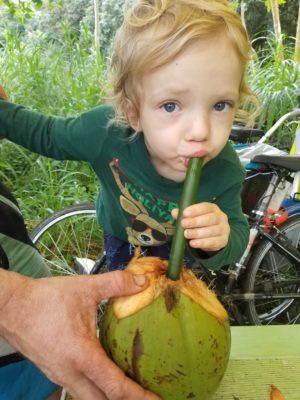
We drank tap water and never bought water, and to be honest, we are against buying bottled water. On a few, rare occasions, we could only find non-potable water (by the Olivine Pools and some of the wayside parks on the way out of Hana), but generally it was easy to find potable tap water. We had a 10L Ortlieb water bag which we filled up if we anticipated not being able to find clean water, such as when camping at Plenty Kiawe, on the Piilani Highway, and used our iodine crystals just that one time by the Olivine Pools.
Where to Stay
If you are planning to stay at hotels, B&B’s or AirBnB, beware that rooms go for $200+ per night, at least during the high season. Our flight arrived late at night and that was the only night that we paid for indoor accommodation, but it cost us an arm and a leg, for an ok room in someone’s house… Warmshowers and Couchsurfing could be an option, although there are precious few hosts and as applies to most touristy destinations, they get many requests. That being said, we had an absolutely wonderful Warmshowers host for a few nights, so it’s definitely worth a try.
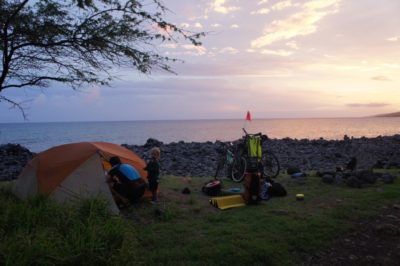
Regarding camping and wild camping: there are only a few official or unofficial campgrounds, and the ones we recommend are marked on our map. At the time of our trip, the three county campgrounds were closed, apparently due to a “homeless person problem”, but they might reopen in the future. The only campground we booked was Waiʻanapanapa, which is the only one that you absolutely have to book (at least theoretically), since they don’t take payment at the campground. We found wild camping to be quite easy, even with a three year-old, but we were fairly careful – choosing a good location, setting up after dark, and so on. We were told several times by locals both on Maui and the Big Island (excellent for cycling as well!) that if you put out a fishing rod by your tent, you can get away with camping at most beaches, but we couldn’t be bothered to lug a fishing rod around the island with us (note: one doesn’t need a fishing license to fish). Usually camping in people’s yards (with permission, of course!) works quite well, but we didn’t end up doing that on this trip at all. Another option are some private camping options listed on Hipcamp, currently showing some expensive but nice-looking options.
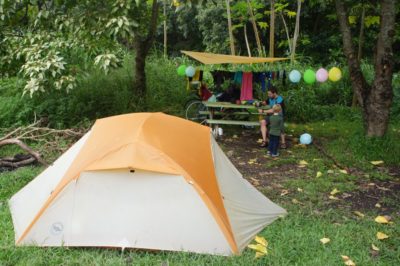
Sidetrips: Beaches, Hiking, Snorkelling and Surfing
One could apparently spend a lifetime exploring the beaches on Maui, there are just so many… Some of the more unique ones include the Red Sand Beach in Hana, Ho’okipa Beach where there are turtles and world class surfers and windsurfers, and the Black Sand Beach at Waiʻanapanapa State Park. Many of the beaches have good snorkelling and surfing. For a detailed description of most of the beaches, see the excellent Maui Revealed guidebook. Winter is whale season, and whales can often be seen from shore, especially on the section between Lahaina and Māʻalaea. To increase your chances of seeing whales up close, consider taking a whale watching tour (we went with Pacific Whale), or taking the ferry to Lanai. For world class snorkelling, consider doing a day trip to Molokini (we took the Four Winds II which is a good option with kids), where the visibility is incredible.
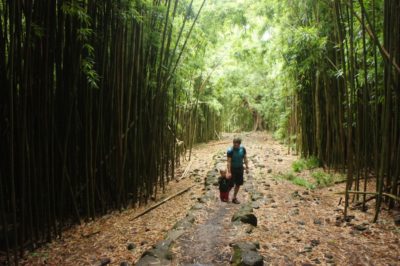
A trip to the top of Haleakala (at 3,055m), if you can get a ride or are able to ride up to the summit, would probably be well worth the effort (we didn’t end up going), for the views and unique landscape – consider camping there, but bring warm clothing. From Kipahulu, we recommend a visit to the Pools of Ohe’o (“the Seven Scared Pools”), as well as the Pipiwai Trail, which visits two waterfalls and passes through a wonderful bamboo forest. Venus Pools (Waioka Pond) is a unique protected ocean pool with some high jumps for the brave and a semi-secret location (but it’s now on Google Maps…).
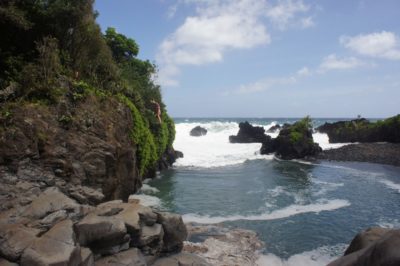
If you have extra time (like us), consider doing a side trip to Lanai (island) – there is a ferry from Lahaina. From the ferry we saw lots of whales, and the camping at Hulopo‘e Beach is incredible – just make sure to find a local to tag on to, or you’ll be saddled with $80/night and have to camp in the woods instead of on the beach. There’s a very worthwhile short hike to Puu Pehe (Sweetheart Rock), and don’t forget to check out the neat natural pool on the way there. The fancy Four Seasons Hotel is worth a look, but note: the cheapest room is over $1,000 a night. We didn’t end up doing any cycling on Lanai, but the Garden of the Gods looks well worth a visit, as well as Polihua Beach.
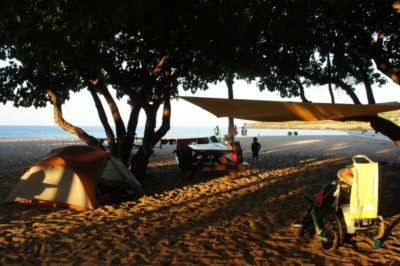
Guidebook/Maps/Internet
The best guidebook for Maui, by far, is Maui Revealed. It is incredibly detailed, and includes directions to some of the more secretive locations, such as the Red Sand Beach in Hana, Venus Pools, and so on. We didn’t know about that guidebook and brought an electronic copy of the Lonely Planet with us instead. We barely looked at it, since precious little of it is relevant to cycle tourers. We like paper maps, so we brought along the ITMB Hawaii Map, which includes all of the Hawaiian islands (so you can re-use it on trips to other Hawaiian islands) and is printed on tear-proof paper so it’s more likely to last than a paper map. We also used Google Maps for more detailed maps and RideWithGPS for elevation profiles. On our first day in Kahului we bought an AT&T SIM at Target, and made the mistake of leaving the store without activating it. We never did manage to activate it… Luckily we were able to return it one week later after doing the western loop, and bought another SIM at Walmart (yikes!), which worked fine. That being said, we found that reception was a bit hard to find on the eastern loop as well as places to charge if you mostly camp, and we felt that we could have managed ok without buying a plan.
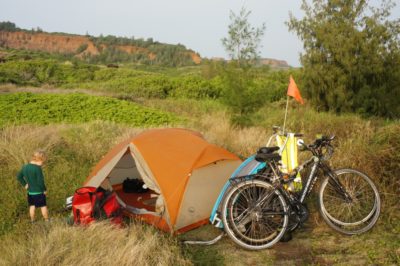
Summary
Having cycled the Big Island before, we were a bit worried that Maui would disappoint. Various people tried to scare us by telling us about the busy and narrow roads, the “fact” that Maui is a series of strip malls and resorts strung together, and that we would surely fall off a cliff on the Hana Highway. Looking for info online, we invariably came across posts about how dangerous it is to camp wild in Hawaii, and how likely we were to be mugged or find a junkie at our tent door. Searching for accommodation, we came to the conclusion that Maui is an expensive place and that vacationing there is for the rich only.
The truth, however, is out there, and is very different from all of this. We found Maui to be an incredibly scenic place, with smooth roads, many of which are surprisingly rural and remote, friendly down to earth people, relatively cheap or free accommodation (if camping), and in general – a magical place. Our three year old son seemed to enjoy every moment, especially our many encounters with marine life – whales, sea turtles, and dolphins, wild coconuts and papayas and the countless missions to pick them, and of course playing in the sand at one of Maui’s gorgeous beaches. Go cycle Maui and I bet you won’t be disappointed!
View Figure Eight Around Maui in a larger map
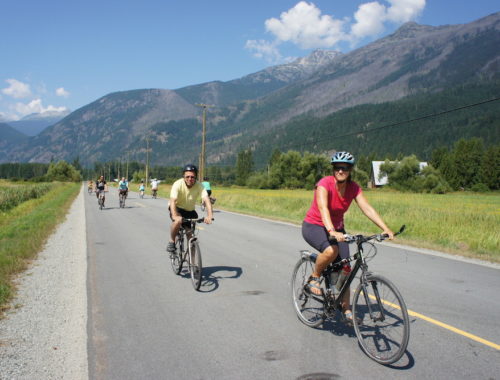
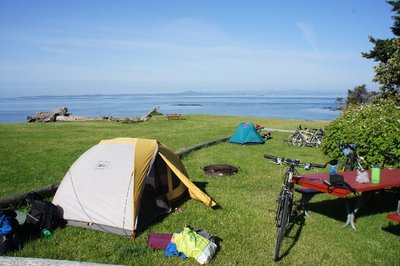
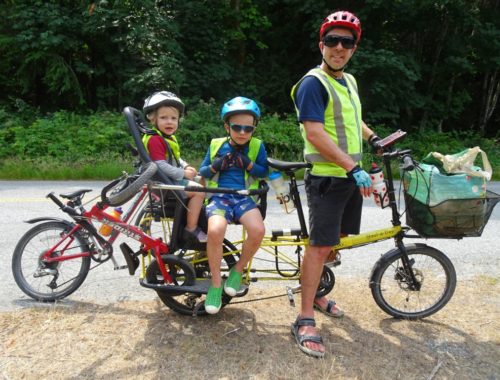
2 Comments
Nicole
All cyclists will really appreciate this amazingly thorough and very informative and easy-to-read account of cycling Maui! WOW! Great!
Gili
Cycling Maui was an absolutely magical experience, and at the risk of overusing a cliché, it literally took our breath away countless times. There isn’t much information available online on cycling Maui, and probably not many people do it. It’s our hope that this little guidebook will help others who would like to explore Maui by bicycle to have (at least) a similarly wonderful experience.